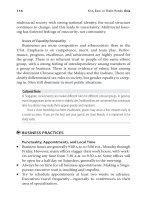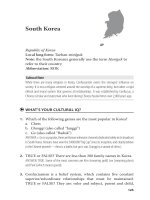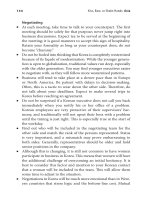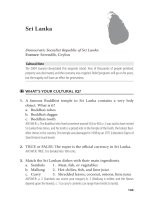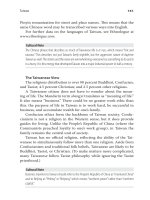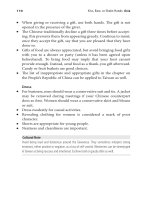How to Do Business in 12 Asian Countries 17
Bạn đang xem bản rút gọn của tài liệu. Xem và tải ngay bản đầy đủ của tài liệu tại đây (134.88 KB, 9 trang )
125
South Korea
Republic of Korea
Local long form: Taehan-min’guk
Note: the South Koreans generally use the term Han’guk to
refer to their country
Abbreviation: ROK
Cultural Note
While there are many religions in Korea, Confucianism exerts the strongest influence on
society. It is not a religion centered around the worship of a supreme deity, but rather a rigid
ethical and moral system that governs all relationships. It was established by Confucius, a
Chinese scholar and statesman who lived during Chinese feudal times over 2,000 years ago.
●
3
WHAT’S YOUR CULTURAL IQ?
1.
Which of the following games are the most popular in Korea?
a. Chess
b.
Changgi (also called “Janggi”)
c.
Go (also called “Baduk”)
ANSWER: c. Go is so popular, there are Korean television channels dedicated solely to its broadcast
in South Korea. Koreans have won the $400,000 “Ing Cup” since its inception, and clearly believe
in the Chinese proverb—chess is a battle, but go is war. (Janggi is a variant of chess.)
2.
TRUE or FALSE? ere are less than 300 family names in Korea.
ANSWER: TRUE. Some of the most common are Kim (meaning gold) Lee (meaning plum)
and Park (which means gourd).
3.
Confucianism is a belief system, which contains ve constant
superior/subordinate relationships that must be maintained.
TRUE or FALSE? ey are: ruler and subject, parent and child,
126
Kiss, Bow, or Shake Hands: Asia
elder and younger brother, husband and wife, elder friend and
younger friend.
ANSWER: TRUE. Confucianism also mandates Jen (a sense of duty to humanity), Shu
(reciprocity—“Do unto others as you would have them do unto you,” similar to the Gospel of
Matthew 7:12), Chih (wisdom), Wen (representing all the arts), and respect for the Chun tzu
(the civilized man who has developed all the virtues).
●
3
TIPS ON DOING BUSINESS IN SOUTH KOREA
●
Koreans are more independent and individualistic than their
Asian neighbors. ey are the most straightforward of all Asians
but can also be defensive, a trait stemming from a history of inva-
sion by their neighbors.
●
Seers are oen consulted by Koreans in all walks of life. Even
executives confer with them about business transactions. A nega-
tive report from a seer, or fortuneteller, could ruin an entire deal.
A fortuneteller is called a mudang in Korean.
●
Bad news is never given to a manager at the start of the day.
●
Foreigners should attempt to show proper respect to Korean
supervisors. is includes not putting anything on the manager’s
desk (not even sales literature) during a presentation. Korean
executives are very territorial about their desks.
●
Koreans do not maintain as much eye contact as North Americans.
As a general rule, Koreans of equal status will look at each other
only half of the time during their conversation. When persons are
of unequal status, the lower-ranking person will oen avert his or
her eyes during much of the conversation. Extended or intense
eye contact can be associated with anger. North Americans who
try to maintain continuous eye contact with a Korean may appear
hostile or aggressive.
●
3
COUNTRY BACKGROUND
Demographics
South Korea’s population of 49 million (2006 estimate) is ethnically
homogeneous (99.9 percent Korean with a small Chinese minority).
History
Korea’s original name, Choson, meant “land of the morning calm.”
e country’s history has been shaped by frequent invasions from
its neighbors. Korean history is divided into three main periods:
the Silla (668–935), Koryo (935–1392), and Yi (1392–1910) dynas-
ties. e name “Korea” is derived from the middle dynasty of Koryo.
Foreign inuence—direct and indirect—occurred throughout these
dynasties. All of Korea’s foreign overlords—Mongolian, Chinese, and
Japanese—instituted a closed-door policy in order to solidify their
rule. is isolation earned Korea the name of the Hermit Kingdom.
In 1910, Japan annexed Korea and enforced ruthless control,
outlawing Korean culture and language. Despite resistance, several
generations grew up more familiar with Japanese than with Korean
customs. At the Yalta Conference at the end of World War II, the
United States of America and the Soviet Union jointly established
temporary administrative trusteeship over Korea until democratic
elections could be held. Japanese forces south of the thirty-eighth
parallel surrendered to the USA and forces in the north surrendered
to the USSR. e Soviets blocked attempts to hold nationwide elec-
tions, and the two sides became deadlocked. When authorities in the
north ignored a United Nations resolution for supervised elections
in 1948, a pro-Western government was established in the south (the
Republic of Korea). Later the Soviet Union established the Demo-
cratic People’s Republic of Korea in the north. In June 1949, U.S.
troops withdrew.
One year later, North Korean forces invaded South Korea. A
United Nations–backed coalition of sixteen member nations sent
assistance to South Korea. e resulting war lasted three years and
ended in a stalemate. On July 27, 1953, an armistice agreement was
signed and a Military Armistice Commission with ve members for
each side was set up to supervise the implementation of the armi-
stice. Neither the USA nor South Korea ever signed the agreement
(although they respect the terms as members of the United Nations),
so a state of war is formally still in eect.
e United States of America still maintains a military presence
in South Korea, although feelings that this should end are growing.
South Korea
127
128
Kiss, Bow, or Shake Hands: Asia
e year 1980 marked the beginning of Korea’s focused develop-
ment of a high-tech industry. It was also the year of the Kwangju
massacre, when government troops killed hundreds of demonstra-
tors who were part of a prodemocracy movement. In 1988 Seoul
hosted the Olympic games (when restaurants removed dog from
their menus in deference to delicate Western sensibilities), and Korea
held their rst free parliamentary elections. South (and North) Korea
joined the United Nations in 1991, and in 2000, former president
Kim Dae Jung received the Nobel Peace Prize. In 2004, a site was
chosen for the new capital city in the Yeongi-Kwangju area.
Cultural Note
Prior to the 1950s, North Korea was the industrial heartland of the peninsula. However, their
industries have been dwarfed by South Korea’s modernization. Nighttime satellite photos
prove how different the economies of North and South Korea have become. At night, Seoul
is a brilliantly lit site in the glowing, prosperous southern half of the peninsula. In contrast,
North Korea’s lights are sporadic and dim—mute evidence of the slower development of
North Korea.
Type of Government
South Korea is a unitary multiparty republic, governed by a
president, prime minister, deputy prime minister, and State Coun-
cil (cabinet). ere is also a unicameral National Assembly and a
Supreme Court.
e prime minister is the head of the government. e chief of
state is the president, who is elected to a ve-year term. Members of
the National Assembly serve a four-year term.
Current government data can be found at the Embassy of South
Korea at www.koreaembassyusa.org.
Language
Korean is the ocial language of South Korea. English is widely
taught in schools. erefore, businesspeople are oen familiar with
English, especially in urban areas.
Korean is a Ural-Altaic language, but, unlike Japanese and Chi-
nese, Korean does not use tones. Approximately 1,300 Chinese char-
acters are used in modern Korean. e literacy rate is 92 percent, and
newspaper readership is very high in South Korea.
Cultural Note
Which of the following is the correct method of transliterating the twenty-four-letter Korean
alphabet into the twenty-six-letter Roman alphabet?
•
The McCune-Reischauer method
•
The Korean government’s method
•
Everyone else’s method
•
All of the above
The correct answer is “all of the above.” Because of the variety of transliterations, Korean
words can be spelled multiple ways in English.
The South Korean View
Dominant religions include Confucianism, Christianity (26 per-
cent of the population), Buddhism, Shamanism (spirit worship), and
Chondokyo (religion of the heavenly way). South Korea is a society
run along Confucian precepts. In fact, Confucianism may have had
a more profound eect on Korea than it had even in China, where
Confucianism originated. (Remember that Confucianism is not a
religion in the classic sense of the word. Rather, it is a philosophy and
guide for living.)
Confucius taught that the basic unit of society is the family. In
order to preserve harmony in the home, certain reciprocal respon-
sibilities must be preserved in relationships. ese relationships are
between ruler and subjects, between husband and wife, between
father and son, between elder brother and younger brother, and
between friends. Because all but the last are hierarchical, rank and
age are very important in all interactions. While all actions of the
individual reect upon the family, lial piety is of utmost impor-
tance. Virtues of kindness, righteousness, propriety, intelligence, and
faithfulness are also revered.
South Korea
129



